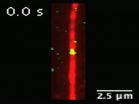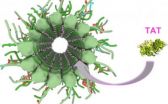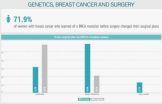(Press-News.org) VIDEO:
Researchers watched TAT proteins (green) journey into microtubules (red). TAT proteins are known to label the insides of the tubes. They observed that TAT can move quickly, back and...
Click here for more information.
In a new study, scientists at the National Institutes of Health took a molecular-level journey into microtubules, the hollow cylinders inside brain cells that act as skeletons and internal highways. They watched how a protein called tubulin acetyltransferase (TAT) labels the inside of microtubules. The results, published in Cell, answer long-standing questions about how TAT tagging works and offer clues as to why it is important for brain health.
Microtubules are constantly tagged by proteins in the cell to designate them for specialized functions, in the same way that roads are labeled for fast or slow traffic or for maintenance. TAT coats specific locations inside the microtubules with a chemical called an acetyl group. How the various labels are added to the cellular microtubule network remains a mystery. Recent findings suggested that problems with tagging microtubules may lead to some forms of cancer and nervous system disorders, including Alzheimer's disease, and have been linked to a rare blinding disorder and Joubert Syndrome, an uncommon brain development disorder.
"This is the first time anyone has been able to peer inside microtubules and catch TAT in action," said Antonina Roll-Mecak, Ph.D., an investigator at the NIH's National Institute of Neurological Disorders and Stroke (NINDS), Bethesda, Maryland, and the leader of the study.
Microtubules are found in all of the body's cells. They are assembled like building blocks, using a protein called tubulin. Microtubules are constructed first by aligning tubulin building blocks into long strings. Then the strings align themselves side by side to form a sheet. Eventually the sheet grows wide enough that it closes up into a cylinder. TAT then bonds an acetyl group to alpha tubulin, a subunit of the tubulin protein.
Some microtubules are short-lived and can rapidly change lengths by adding or removing tubulin pieces along one end, whereas others remain unchanged for longer times. Recognizing the difference may help cells function properly. For example, cells may send cargo along stable microtubules and avoid ones that are being rebuilt. Cells appear to use a variety of chemical labels to describe the stability of microtubules.
"Our study uncovers how TAT may help cells distinguish between stable microtubules and ones that are under construction," said Dr. Roll-Mecak. According to Dr. Roll-Mecak, high levels of microtubule tagging are unique to nerve cells and may be the reason that they have complex shapes allowing them to make elaborate connections in the brain.
For decades scientists knew that the insides of long-lived microtubules were often tagged with acetyl groups by TAT. Changes in acetylation may influence the health of nerve cells. Some studies have shown that blocking this form of microtubule tagging leads to nerve defects, brain abnormalities or degeneration of nerve fibers. Since the discovery of microtubule acetylation, scientists have been puzzled about how TAT accesses the inside of the microtubules and how the tagging reaction happens.
To watch TAT at work, Dr. Roll-Mecak and her colleagues took high resolution movies of individual TAT molecules interacting with microtubules in real time. They saw that TAT surfs through the inside of microtubules and although it can find acetylation sites quickly, the process of adding the tag occurs very slowly.
In general, tagging reactions work like keys fitting into locks: the better the key fits, the faster the lock can open. Similarly, the rate of the reactions is determined by how well TAT molecules fit around tagging sites.
Dr. Roll-Mecak's team investigated this idea by using a technique called X-ray crystallography to look at how atoms on TAT molecules interact with acetylation sites on tubulin molecules. Their results suggested that TAT fit poorly around the sites.
"It looks as though TAT can easily journey through microtubules spotting acetylation sites but may only label those that are stable for longer periods of time," said Dr. Roll-Mecak.
This may help cells identify the microtubules they need to rapidly change shapes or send cargo to other places. Further studies may help researchers understand how microtubule tagging influences nerve cells in health and disease.
INFORMATION:
This work was supported by the NINDS Intramural Research Program, the NHLBI Division of Intramural Research, and the Howard Hughes Medical Institute.
References:
Szyk et al. "Molecular basis for age-dependent microtubule acetylation by tubulin acetyltransferase," Cell, June 5, 2014. DOI: 10.1016/j.cell.2014.03.061
For more information on scientific research conducted at the NIH, please visit:
http://dir1.ninds.nih.gov/ninds/Home.aspx
http://www.nhlbi.nih.gov/research/intramural/
NINDS is the nation's leading funder of research on the brain and nervous system. The mission of NINDS is to seek fundamental knowledge about the brain and nervous system and to use that knowledge to reduce the burden of neurological disease.
Part of the National Institutes of Health, the National Heart, Lung, and Blood Institute (NHLBI) plans, conducts, and supports research related to the causes, prevention, diagnosis, and treatment of heart, blood vessel, lung, and blood diseases; and sleep disorders. The Institute also administers national health education campaigns on women and heart disease, healthy weight for children, and other topics. NHLBI press releases and other materials are available online at http://www.nhlbi.nih.gov.
About the National Institutes of Health (NIH): NIH, the nation's medical research agency, includes 27 Institutes and Centers and is a component of the U.S. Department of Health and Human Services. NIH is the primary federal agency conducting and supporting basic, clinical, and translational medical research, and is investigating the causes, treatments, and cures for both common and rare diseases. For more information about NIH and its programs, visit http://www.nih.gov.
NIH scientists take totally tubular journey through brain cells
Study may advance understanding of how brain cell tubes are modified under normal and disease conditions
2014-06-13
ELSE PRESS RELEASES FROM THIS DATE:
NASA experiments recreate aromatic flavors of Titan
2014-06-13
NASA scientists have created a new recipe that captures key flavors of the brownish-orange atmosphere around Saturn's largest moon, Titan.
The recipe is used for lab experiments designed to simulate Titan's chemistry. With this approach, the team was able to classify a previously unidentified material discovered by NASA's Cassini spacecraft in the moon's smoggy haze.
"Now we can say that this material has a strong aromatic character, which helps us understand more about the complex mixture of molecules that makes up Titan's haze," said Melissa Trainer, a planetary scientist ...
'Exquisitely engineered' human vision featured in Optical Engineering
2014-06-13
BELLINGHAM, Washington, USA — A new special section on Human Vision in the current issue of Optical Engineering showcases optics and optical engineering research into new techniques and approaches for the study of human vision and the design of novel imaging systems. Put into practice, these new approaches enable applications such as earlier diagnosis of disease, improved treatment monitoring, and more accurate guidance for treatment and surgery. The journal is published by SPIE, the international society for optics and photonics.
The special section includes 11 papers ...
NASA sees Tropical Storm Nanauk's soaking swan song
2014-06-13
VIDEO:
This TRMM satellite flyby animation shows that Tropical Storm Nanauk contained powerful towering thunderstorms that were reaching heights of up to 16.8 km (10.4 miles) on June 11, 2014....
Click here for more information.
Tropical Storm Nanauk was dissipating in the Arabian Sea on Friday, June 13 as it ran into increasing vertical wind shear, dry air moving into the tropical cyclone and cooler sea surface temperatures. NASA's TRMM satellite observed the soaking rains the ...
NASA sees Hurricane Cristina making a reverse in strength
2014-06-13
Hurricane Cristina intensified rapidly on June 12 and infrared satellite data showed cloud top temperatures became extremely cold as thunderstorms towered to the top of the troposphere. One day later, Cristina was weakening quickly and infrared data showed cloud top temperatures were warming as the cloud tops dropped.
Infrared data basically reads a cloud top's temperature. When NASA's Aqua satellite passed over Hurricane Cristina early on June 12, cloud top temperatures exceeded -80C (-112F). Today, June 13, infrared data showed cloud top temperatures had warmed to near ...
Nurses play critical role in responding to global resurgence of pertussis
2014-06-13
(June 13, 2014)- Concerted effort is needed to reverse the ongoing rise in pertussis cases and deaths, especially among children and young people, according to the article by Emily Peake, APRN, MSN, FNP-C, CLC, and Lisa K. McGuire, MSN, MBA-HCM, RN. "This effort begins with nurses and nurse practitioners and other primary care providers who educate patients and the public," they write. "The battle of pertussis is winnable through education, awareness, and vaccination."
In US and Abroad, Rising Rates of Pertussis Infection and Death
Caused by infection with Bordetella ...
UH research focuses on how food marketing creates a false sense of health
2014-06-13
Health-related buzzwords, such as "antioxidant," "gluten-free" and "whole grain," lull consumers into thinking packaged food products labeled with those words are healthier than they actually are, according to a new research study conducted by scholars at the University of Houston (UH).
That "false sense of health," as well as a failure to understand the information presented in nutrition facts panels on packaged food, may be contributing to the obesity epidemic in the United States, said Temple Northup, an assistant professor at the Jack J. Valenti School of Communication ...
Who's using your data?
2014-06-13
By now, most people feel comfortable conducting financial transactions on the Web. The cryptographic schemes that protect online banking and credit card purchases have proven their reliability over decades.
As more of our data moves online, a more pressing concern may be its inadvertent misuse by people authorized to access it. Every month seems to bring another story of private information accidentally leaked by governmental agencies or vendors of digital products or services.
At the same time, tighter restrictions on access could undermine the whole point of sharing ...
Moffitt study shows utilizing genetic health care professional reduces unnecessary testing
2014-06-13
TAMPA, Fla. (June 13, 2014) – A new Moffitt Cancer Center study published Thursday in Genetics in Medicine shows that counseling from a genetic health care provider before genetic testing educates patients and may help reduce unnecessary procedures.
Up to 10 percent of cancers are inherited, meaning a person was born with an abnormal gene that increases their risk for cancer. "Pre-test genetic counseling in which a health care provider takes a thorough family history and discusses the potential risks and benefits of genetic testing is standard of care as recommended ...
BRCA test results affect patients' breast cancer surgery plans
2014-06-13
PROVIDENCE, R.I. [Brown University] —Women diagnosed with breast cancer often face a crucial decision about the extent of their surgical treatment. Many meet national guidelines recommending testing for mutations in the BRCA 1 and 2 genes, which carry a substantial risk of future cancer. A new study reports that among women with breast cancer who undergo recommended testing before surgery, more than 7 in 10 who test positive will change their surgical plan, typically opting for a more extensive procedure such as a double mastectomy and sometimes ovary removal.
"As soon ...
Charity funding study brings alcohol industry influence on UK policy into question
2014-06-13
Five charities in the UK are both active in alcohol policy processes and funded by the alcohol industry, according to a new study published in the European Journal of Public Health.
The study, carried out by researchers at the London School of Hygiene & Tropical Medicine, looks at the relationships between the alcohol industry, charities and policy influence in the UK.
Two of the charities, Addaction and Mentor UK, are the only remaining non-industry, non-governmental members of the Public Health Responsibility Deal's alcohol network – the UK government's initiative ...
LAST 30 PRESS RELEASES:
Tracing the quick synthesis of an industrially important catalyst
New software sheds light on cancer’s hidden genetic networks
UT Health San Antonio awarded $3 million in CPRIT grants to bolster cancer research and prevention efforts in South Texas
Third symposium spotlights global challenge of new contaminants in China’s fight against pollution
From straw to soil harmony: International team reveals how biochar supercharges carbon-smart farming
Myeloma: How AI is redrawing the map of cancer care
Manhattan E. Charurat, Ph.D., MHS invested as the Homer and Martha Gudelsky Distinguished Professor in Medicine at the University of Maryland School of Medicine
Insilico Medicine’s Pharma.AI Q4 Winter Launch Recap: Revolutionizing drug discovery with cutting-edge AI innovations, accelerating the path to pharmaceutical superintelligence
Nanoplastics have diet-dependent impacts on digestive system health
Brain neuron death occurs throughout life and increases with age, a natural human protein drug may halt neuron death in Alzheimer’s disease
SPIE and CLP announce the recipients of the 2025 Advanced Photonics Young Innovator Award
Lessons from the Caldor Fire’s Christmas Valley ‘Miracle’
Ant societies rose by trading individual protection for collective power
Research reveals how ancient viral DNA shapes early embryonic development
A molecular gatekeeper that controls protein synthesis
New ‘cloaking device’ concept to shield sensitive tech from magnetic fields
Researchers show impact of mountain building and climate change on alpine biodiversity
Study models the transition from Neanderthals to modern humans in Europe
University of Phoenix College of Doctoral Studies releases white paper on AI-driven skilling to reduce burnout and restore worker autonomy
AIs fail at the game of visual “telephone”
The levers for a sustainable food system
Potential changes in US homelessness by ending federal support for housing first programs
Vulnerability of large language models to prompt injection when providing medical advice
Researchers develop new system for high-energy-density, long-life, multi-electron transfer bromine-based flow batteries
Ending federal support for housing first programs could increase U.S. homelessness by 5% in one year, new JAMA study finds
New research uncovers molecular ‘safety switch’ shielding cancers from immune attack
Bacteria resisting viral infection can still sink carbon to ocean floor
Younger biological age may increase depression risk in older women during COVID-19
Bharat Innovates 2026 National Basecamp Showcases India’s Most Promising Deep-Tech Ventures
Here’s what determines whether your income level rises or falls
[Press-News.org] NIH scientists take totally tubular journey through brain cellsStudy may advance understanding of how brain cell tubes are modified under normal and disease conditions








